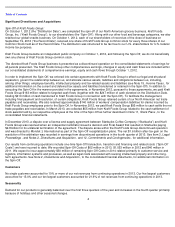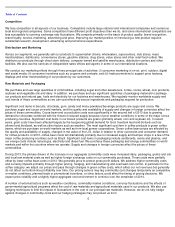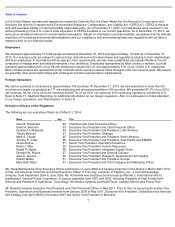Mondelez 2013 Annual Report Download - page 17
Download and view the complete annual report
Please find page 17 of the 2013 Mondelez annual report below. You can navigate through the pages in the report by either clicking on the pages listed below, or by using the keyword search tool below to find specific information within the annual report.
Table of Contents
We may also suffer losses if our products or operations violate applicable laws or regulations, or if our products cause injury, illness
or death. In addition, our marketing could face claims of false or deceptive advertising or other criticism. A significant product
liability or other legal judgment against us, a related regulatory enforcement action or a widespread product recall may materially
and adversely affect our reputation and profitability. Moreover, even if a product liability or consumer fraud claim is unsuccessful,
has no merit or is not pursued, the negative publicity surrounding assertions against our products or processes could materially and
adversely affect our reputation, product sales, financial condition and results of operations.
Unanticipated business disruptions could adversely affect our ability to provide our products to our customers and our
results of operations.
We manufacture and source products and materials on a global scale. We have a complex network of suppliers, owned
manufacturing locations, co-manufacturing locations, distribution networks and information systems that support our ability
consistently to provide our products to our customers. Factors that are hard to predict or beyond our control, like weather, natural
disasters, fire, explosions, terrorism, political unrest, generalized labor unrest or health pandemics, could damage or disrupt our
operations, or our suppliers’ or co-manufacturers’ operations. If we cannot respond to disruptions in our operations, for example, by
finding alternative suppliers or replacing capacity at key manufacturing or distribution locations, or cannot quickly repair damage to
our information, production or supply systems, we may be late in delivering or unable to deliver products to our customers. If that
occurs, we may lose our customers’ confidence, and long-term consumer demand for our products could decline. In addition, we
might not have the functions, processes or organizational capability necessary to achieve on our anticipated timeframes our
strategic ambition to reconfigure our supply chain and drive efficiencies to fuel growth. These events could materially and adversely
affect our product sales, financial condition and results of operations.
We must correctly predict, identify and interpret changes in consumer preferences and demand, and offer new products
to meet those changes.
Consumer preferences for food and snacking products change continually. Our success depends on our ability to predict, identify
and interpret the tastes and dietary habits of consumers around the world and to offer products that appeal to consumer
preferences. If we do not offer products that appeal to consumers or if we misjudge consumer demand for our products, our sales
and market share will decrease and our profitability could suffer.
We must distinguish among short-term fads, mid-term trends and long-term changes in consumer preferences. If we do not
accurately predict which shifts in consumer preferences will be long-term, or if we fail to introduce new and improved products to
satisfy those preferences, our sales could decline. In addition, because of our varied consumer base, including by geography, we
must offer an array of products that satisfy the broad spectrum of consumer preferences. If we fail to expand our product offerings
successfully across product categories, or if we do not rapidly develop products in faster growing and more profitable categories,
demand for our products will decrease and our profitability could suffer.
Prolonged negative perceptions concerning the health implications of certain food products could influence consumer preferences
and acceptance of some of our products and marketing programs. For example, recently, consumers have increasingly focused on
health and wellness, including weight management and reducing sodium consumption. We strive to respond to consumer
preferences and social expectations, but we may be unsuccessful in these efforts. Continued negative perceptions and failure to
satisfy consumer preferences could materially and adversely affect our reputation, product sales, financial condition and results of
operations.
We may not successfully identify, complete or manage strategic transactions, which could have a material adverse effect
on our business, financial condition and operating results.
We evaluate a variety of potential strategic transactions, including acquisitions, divestitures, joint ventures, minority investments
and other strategic alliances, that could further our strategic business objectives. We may not successfully identify, complete or
manage the risks presented by these strategic transactions. Strategic transactions may result in the diversion of management
attention from our existing business and may present financial, managerial and operational risks. Our success depends, in part,
upon our ability to identify suitable transactions; negotiate favorable contractual terms; comply with applicable regulations and
receive necessary consents, clearances and approvals (including regulatory and antitrust clearances and approvals); integrate or
separate businesses; realize the full extent of the benefits, cost savings or synergies presented by strategic transactions; effectively
implement control environment processes with employees joining us as a result of transactions; minimize adverse effects on
existing business relationships with suppliers and customers; achieve accurate estimates of fair value; minimize potential loss of
customers or key employees; and minimize indemnities and potential disputes with buyers, sellers and strategic partners.
13
























